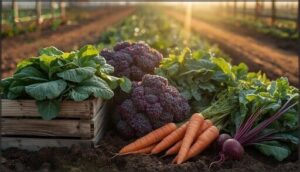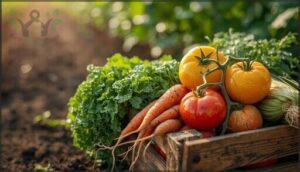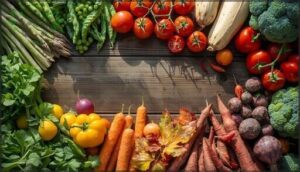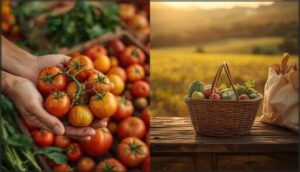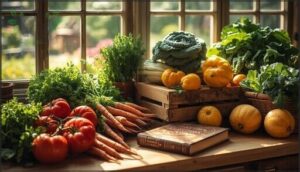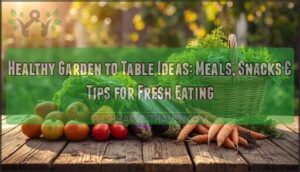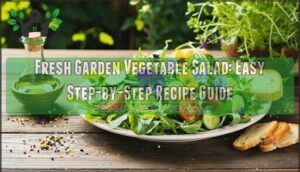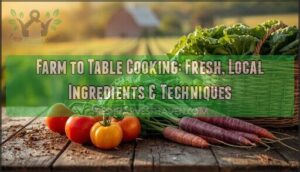This site is supported by our readers. We may earn a commission, at no cost to you, if you purchase through links.
Winter spinach can pack up to 436 mg/kg of vitamin C—roughly triple what you’d find in the same greens grown mid-summer. That’s not a marketing claim or a wellness trend, it’s basic plant biology. Produce harvested at its natural peak doesn’t just taste better, it delivers considerably more of the nutrients your body needs.
When you grow or buy what’s actually in season, you’re working with nature’s timeline instead of fighting it. The result is food that promotes your health more effectively, costs less, and doesn’t require a cross-country truck ride to reach your plate.
Seasonal eating from the garden isn’t about idealism or rigid rules, it’s about making choices that align with how food naturally grows and when it’s most beneficial to eat.
Table Of Contents
- Key Takeaways
- Why Choose Seasonal Eating From The Garden
- Nutritional and Flavor Benefits of Seasonal Produce
- Environmental and Economic Advantages
- Maximizing Seasonal Eating at Home
- Incorporating Seasonal Produce Into Your Meals
- Frequently Asked Questions (FAQs)
- Why should we eat seasonal produce?
- Should you eat seasonal food?
- What are the benefits of seasonal produce?
- Why should you buy seasonal produce?
- What are the benefits of seasonal eating?
- Why should you eat seasonal vegetables?
- What are common seasonal eating myths to avoid?
- How does seasonality affect food allergen content?
- Can seasonal eating help with specific health conditions?
- How do you transition children to seasonal eating?
- Conclusion
Key Takeaways
- Seasonal produce delivers up to 30% more vitamins and antioxidants than out-of-season imports, with winter spinach containing roughly triple the vitamin C of summer greens, which translates to stronger immune function and better overall health.
- Garden-fresh vegetables retain significantly more nutrients and flavor compounds than store-bought options—homegrown tomatoes have over 100% more vitamin C and lycopene, while fresh corn loses nearly half its sugar content within a week of harvest.
- Eating with the seasons naturally reduces your carbon footprint and grocery costs by 20-30%, since locally grown produce requires minimal transportation and is abundant during peak harvest periods.
- Rotating through seasonal crops throughout the year provides diverse nutrients your body needs at different times while supporting local farmers and sustainable agriculture practices that benefit your community.
Why Choose Seasonal Eating From The Garden
Seasonal eating means choosing fruits and vegetables that naturally grow and ripen during specific times of the year in your local area. When you pick produce straight from the garden or buy it fresh from nearby farms, you’re getting something fundamentally different than what’s been shipped across the country or stored for weeks.
Understanding what sets seasonal eating apart, how garden-fresh produce compares to store-bought options, and why timing matters can help you make choices that benefit both your health and your wallet.
Definition of Seasonal Eating
Seasonal eating means consuming fruits and vegetables during their natural harvest periods in your area. When you eat with regional climate impact in mind, you enjoy freshly harvested, local produce at its peak. This approach emphasizes fresh produce that’s grown nearby, reducing environmental impact while maximizing nutritional value.
Seasonal eating naturally encourages dietary variety as different crops ripen throughout the year, supporting your overall health benefits. This is because fresh produce delivers peak flavor.
How Garden Fresh Differs From Store-Bought
Garden produce reaches your plate within hours of harvest, preserving nutrient density that store-bought options can’t match. Homegrown tomatoes retain over 100% more vitamin C and lycopene compared to varieties picked early for shipping. You’ll also notice better flavor and texture in fresh produce.
Plus, garden-grown items generally have minimal pesticide residue and greater microbial diversity, supporting your gut health naturally. Eating garden-fresh foods increases exposure to microbiota.
Benefits of Eating With The Seasons
When you eat seasonally, you’re choosing produce at its peak nutrition—delivering up to 30% more vitamins and antioxidants than out-of-season imports. This translates to real health benefits of seasonal eating: stronger immune function, better gut health, and reduced pesticide exposure.
Seasonal produce delivers up to 30% more vitamins and antioxidants, strengthening your immune system and gut health naturally
The flavor intensity speaks for itself, too. Seasonal eating isn’t just about what tastes good; it’s about supporting your body’s needs while minimizing environmental impact.
Nutritional and Flavor Benefits of Seasonal Produce
When you pick produce at its peak, you’re getting more than just food—you’re getting nutrition that truly matters. Seasonal fruits and vegetables offer benefits that go far beyond what you’ll find with items shipped from across the globe.
Let’s look at how eating with the seasons transforms both what’s on your plate and how your body reacts to it.
Enhanced Nutrient Density in Fresh Harvests
When you pick produce at its peak, you’re getting nutritional firepower that store-bought options just can’t match. Sunlight intensity and the soil microbiome during natural growing cycles boost vitamin synthesis, delivering nutrient-dense foods with higher nutritional value.
- Winter spinach offers up to 436 mg/kg of vitamin C compared to just 180 mg/kg in summer harvests
- Fall broccoli contains nearly double the vitamin C levels of spring varieties
- Storage comparison shows prolonged transport dramatically reduces vitamins and antioxidants
- Seasonal variety ensures you’re rotating through different minerals like potassium, magnesium, and calcium throughout the year
Fresh harvests preserve these nutritional and flavor benefits, enhancing nutritional value before degradation begins.
Superior Taste and Texture of Garden Produce
Beyond nutrition, there’s a reason garden-to-table meals just hit differently. When you harvest at peak ripeness, you’re capturing fresh flavor profiles that store-bought produce simply can’t deliver. Home garden tomatoes contain up to 50% more seasonal aroma compounds, while your carrots retain 85% of their natural flavor oils compared to 68% in week-old store versions.
| Garden Fresh | Store-Bought |
|---|---|
| Sweet corn at 9.5% sugar | Corn after a week: 5.5% sugar |
| 95% original flavor preserved | 38% flavor loss during transport |
| Lettuce rated 42% crisper | Shipped over 900 miles |
| Full volatile aromatic compounds | Reduced complexity and sweetness |
These produce texture analysis differences explain why 78% of taste-testers prefer homegrown vegetables in blind trials. Garden harvest tips matter: consuming produce within 24 hours preserves that “just-picked” intensity—what sensory experts rate 35% higher in fresh flavor.
Your local food systems offer heirloom varieties with flavor enhancement you won’t find in commercial hybrids bred for shipping durability, not taste. That crunch, that sweetness, that burst of seasonal eating goodness? It’s measurable, and it’s real.
Health Impacts of Seasonal Fruits and Vegetables
When you eat with the seasons, you’re not just enjoying better taste—you’re actively protecting your health. Research confirms that diets rich in seasonal fruits and vegetables deliver disease risk reduction through enhanced nutrient density and micronutrient deficiencies prevention. Here’s what the health benefits of fruits and vegetables can do for you:
- Lower cardiovascular disease, stroke, and cancer risk by up to 13% with five daily servings
- Boost enhanced immune function through vitamin C-rich citrus and beta-carotene-loaded squash
- Improve mental well-being and reduce depressive symptoms through B vitamins and folate
- Prevent iron and vitamin A deficiencies with bioavailable nutrients at peak harvest
- Support respiratory health with nutritional value that reduces mortality by 35%
Seasonal vegetables and seasonal fruits supply phytonutrients that modulate inflammation and strengthen immunity—measurable advantages you can feel.
Variety in Diet and Balanced Nutrition
When you rotate your crops with the seasons, you naturally boost nutrient intake and dietary diversity without extra planning. Different harvests deliver complementary vitamins—fall broccoli packs nearly double the vitamin C of spring crops, while rotating colorful produce increases antioxidant consumption and prevents nutritional monotony.
This culinary variety strengthens nutritional resilience, promotes balanced nutrition, and elevates your overall diet quality through nature’s own schedule.
Environmental and Economic Advantages
Eating seasonally isn’t just good for your body—it’s also kinder to your wallet and the planet. When you choose garden-fresh produce that’s in season, you’re making decisions that ripple outward, affecting everything from carbon emissions to your local economy.
Let’s look at how seasonal eating delivers real environmental and financial benefits that matter in your everyday life.
Lower Carbon Footprint and Reduced Food Miles
When your produce travels hundreds or even thousands of miles from farm to plate, it racks up significant greenhouse gas emissions along the way. Garden-fresh eating slashes those food miles to nearly zero, delivering major environmental benefits.
Local sourcing promotes your carbon footprint and sustainable diet choices. In fact, seasonal carbon reduction from garden emissions savings can cut transportation-related emissions substantially, making a real difference for the planet.
Cost Savings on Grocery Bills
Your grocery budget takes a real hit when you buy out-of-season imports, but seasonal eating flips that script. In-season produce generally costs 20-30% less at local markets, thanks to abundant supply and minimal transport expenses.
Garden yields can save you hundreds annually, while waste reduction keeps more money in your pocket. These economic benefits of seasonal eating add up fast, lowering grocery costs without sacrificing nutrition or flavor.
Supporting Local Farmers and Community
When you shop at your local farmers market, you’re not just buying fresh produce—you’re fueling community food security and strengthening the farmer-consumer connection. Direct purchases keep more dollars circulating in your local economy, with farms generating thirteen jobs per $1 million in local sales compared to just three through distant channels.
This community support builds sustainable agriculture while improving market accessibility initiatives for everyone.
Promoting Sustainable Farming Practices
Beyond supporting your local food systems, seasonal eating champions sustainable farming practices that benefit the planet. Farmers using crop rotation, reduced tillage, and bionutrient use create healthier soil while cutting erosion by up to 50%.
Agroforestry practices capture carbon, and water conservation methods save 30% more water than conventional systems. These sustainable food systems protect environmental sustainability while delivering the fresh produce you enjoy.
Maximizing Seasonal Eating at Home
Once you understand the benefits of seasonal eating, the next step is putting it into practice at home. Knowing what’s in season, how to grow or select the best produce, and where to shop can make this approach both simple and rewarding.
Let’s explore the practical strategies that will help you get the most out of seasonal eating throughout the year.
Identifying What’s in Season Each Month
You can track seasonal cycles with tools like USDA seasonal charts and regional produce calendars that list what’s fresh each month. These monthly harvest guides reflect garden planting windows and local climate patterns, helping you identify what’s in season near you.
Consumer awareness of seasonal eating has grown, making it easier to find fresh produce that aligns with your region’s harvest schedule throughout the year.
Selecting and Growing Garden Crops by Season
Once you know what’s available, you can start growing a seasonal garden suited to your climate. Cool-season crops like lettuce and kale thrive when soil temperatures sit around 40–60°F, while warm-season crops such as tomatoes and peppers need warmer conditions above 60°F.
Succession planting and crop rotation let you harvest continuously, maximizing your space and supporting climate adaptation for year-round seasonal eating.
Harvesting and Preserving for Year-Round Use
You can enjoy garden-fresh food all year by mastering harvesting techniques and preservation methods. Pick vegetables at peak ripeness—tomatoes should be firm and fully colored, while green beans are best at 5 to 8 inches long.
Freezing retains most nutrients, while canning and fermenting create shelf-stable options. These storage techniques reduce waste and support seasonal eating year-round.
Shopping at Farmers’ Markets and CSAs
When you shop at farmers markets and CSA programs, you support the local economy while accessing peak-quality produce. Local farmers retain up to 45 cents per dollar compared to chain stores, strengthening market community connections.
Over 75% of market shoppers report eating healthier, and CSA benefits include seasonal variety for 13 weeks or more. Freshness factors and consumer motivations align perfectly with sustainable eating goals.
Incorporating Seasonal Produce Into Your Meals
Once you’ve stocked up on seasonal produce, the next step is figuring out how to actually use it in your everyday cooking.
This section breaks down practical ways to turn fresh ingredients into meals that taste better and work with your schedule. You’ll find recipe ideas, planning strategies, and tips to make seasonal eating feel natural rather than complicated.
Creative Garden-to-Table Recipes
Transform your harvest into delicious, nutrient-rich meals with simple garden-to-table recipes. A quick ratatouille simmered in 20 minutes showcases zucchini, eggplant, and tomatoes while boosting recipe nutrient density.
Try fresh tomato salsa combining sweet corn and herbs for culinary exploration, or create foil-packet meals with seasonal vegetables for sustainable recipes.
These flavor combinations highlight garden-fresh benefits, making healthy recipes both accessible and rewarding for your table.
Tips for Meal Planning With Seasonal Foods
By following a harvest calendar, you’ll align your meal plan with peak availability, reducing costs through sale cycles while incorporating seasonal produce into healthy recipes.
Batch cooking staples alongside fresh finds maximizes efficiency, and food preservation extends your harvest’s reach.
Produce substitutions keep variety in diet interesting throughout the year, making seasonal eating both practical and budget-friendly for your table.
Enhancing Meal Quality and Variety
Garden-fresh ingredients transform everyday cooking into something special. When you incorporate seasonal produce, you’ll notice enhanced taste and aroma that store-bought items simply can’t match. This freshness and flavor of foods elevates meal satisfaction while nutritional retention remains high.
- Enhancing the quality of meals through peak-ripeness harvests
- Variety in diet and nutrition by rotating seasonal options
- Culinary exploration and creativity with new textures and combinations
- Visual appeal from vibrant, colorful ingredients
Encouraging Mindful and Healthy Eating Habits
Seasonal eating naturally guides you toward mindful eating and healthy eating habits that benefit your health and wellbeing. When you choose garden-fresh produce, you’re more likely to recognize hunger cues and plan meals thoughtfully, leading to healthier lifestyle choices and better diet diversity.
Research shows that mindful eating reduces overeating by approximately 20% while encouraging you to appreciate food textures and flavors more fully.
| Mindful Practice | Impact on Health |
|---|---|
| Reducing food waste through intentional use | Aids sustainable habits and saves money |
| Mindful meal planning with seasonal variety | Increases nutrient intake by 30% |
| Community garden impact and local engagement | Enhances diet variety maintenance and social connections |
Frequently Asked Questions (FAQs)
Why should we eat seasonal produce?
Eating with the seasons means you’re choosing produce at its nutritional peak, when flavors are brightest and vitamins most abundant.
You’ll support local agriculture, reduce emissions, save money, and enjoy fresher ingredients that make building a healthier lifestyle deliciously simple.
Should you eat seasonal food?
You don’t have to, but here’s something to think about: a head of fall broccoli contains nearly twice the vitamin C of spring broccoli.
Seasonal eating offers nutritional superiority, environmental impact reduction, and economic viability.
What are the benefits of seasonal produce?
Fresh produce at peak ripeness delivers higher nutrient density, enhanced flavor advantages, and notable economic advantages. The health impacts include disease prevention, while seasonal eating benefits local farms and reduces environmental strain.
Why should you buy seasonal produce?
You should buy seasonal produce because it offers peak ripeness, enhanced nutrient density, and better flavor while reducing environmental impact.
Additionally, you’ll enjoy economic savings and directly support local farmers at markets.
What are the benefits of seasonal eating?
Think of seasonal eating as nature’s nutrition prescription—you’ll enjoy enhanced nutrient density, finer flavor profiles, and a reduced carbon footprint while supporting local farmers.
It’s a mindful habit with measurable health benefits and a positive environmental impact.
Why should you eat seasonal vegetables?
Seasonal vegetables offer peak nutrient density, enhanced flavor and texture, plus environmental impact benefits. You’ll enjoy economic savings and a healthier diet when choosing produce at its nutritional prime, supporting both your health and sustainable practices.
What are common seasonal eating myths to avoid?
Many believe eating with the seasons means only local produce, costs more, or limits variety.
In reality, seasonal eating offers health benefits, a sustainable lifestyle, and diverse healthy eating options despite these cost misconceptions.
How does seasonality affect food allergen content?
Environmental factors like pollen cross-reactivity and climatic conditions influence allergen levels in fresh produce. Harvest maturity and storage methods also affect allergenicity, though geographic location and seasonal variations create unpredictable patterns in food allergen content.
Can seasonal eating help with specific health conditions?
Like tuning a telegraph for wellness, eating garden-fresh produce aids diabetes management, heart health, inflammation reduction, immune support, and gut health.
It offers targeted health benefits that help prevent chronic diseases through seasonal eating patterns.
How do you transition children to seasonal eating?
Start by involving children in gardening and food preparation. Let them choose seeds, harvest produce, and help cook seasonal meals.
Use sensory experiences, fun rewards, and parental modeling to build healthy eating habits naturally.
Conclusion
Think of your garden as a calendar that feeds you—each season marking time with what grows best, tastes brightest, and offers the most nutrition.
When you embrace seasonal eating benefits, garden-fresh produce provides more than just better food. You’re building a rhythm with the land, strengthening your health with every harvest, and lightening your impact on the planet.
It’s simple, intentional eating that works because it follows nature’s lead.
- https://pmc.ncbi.nlm.nih.gov/articles/PMC10969708/
- https://www.webmd.com/diet/what-to-know-seasonal-eating
- https://hgic.clemson.edu/the-benefits-of-seasonal-eating-fresh-nutrient-dense-and-budget-friendly/
- https://www.technologynetworks.com/applied-sciences/news/community-gardens-have-six-times-the-carbon-footprint-of-agriculture-383009
- https://www.vitality.co.uk/magazine/how-seasonal-eating-can-benefit-your-health-and-your-pocket/


